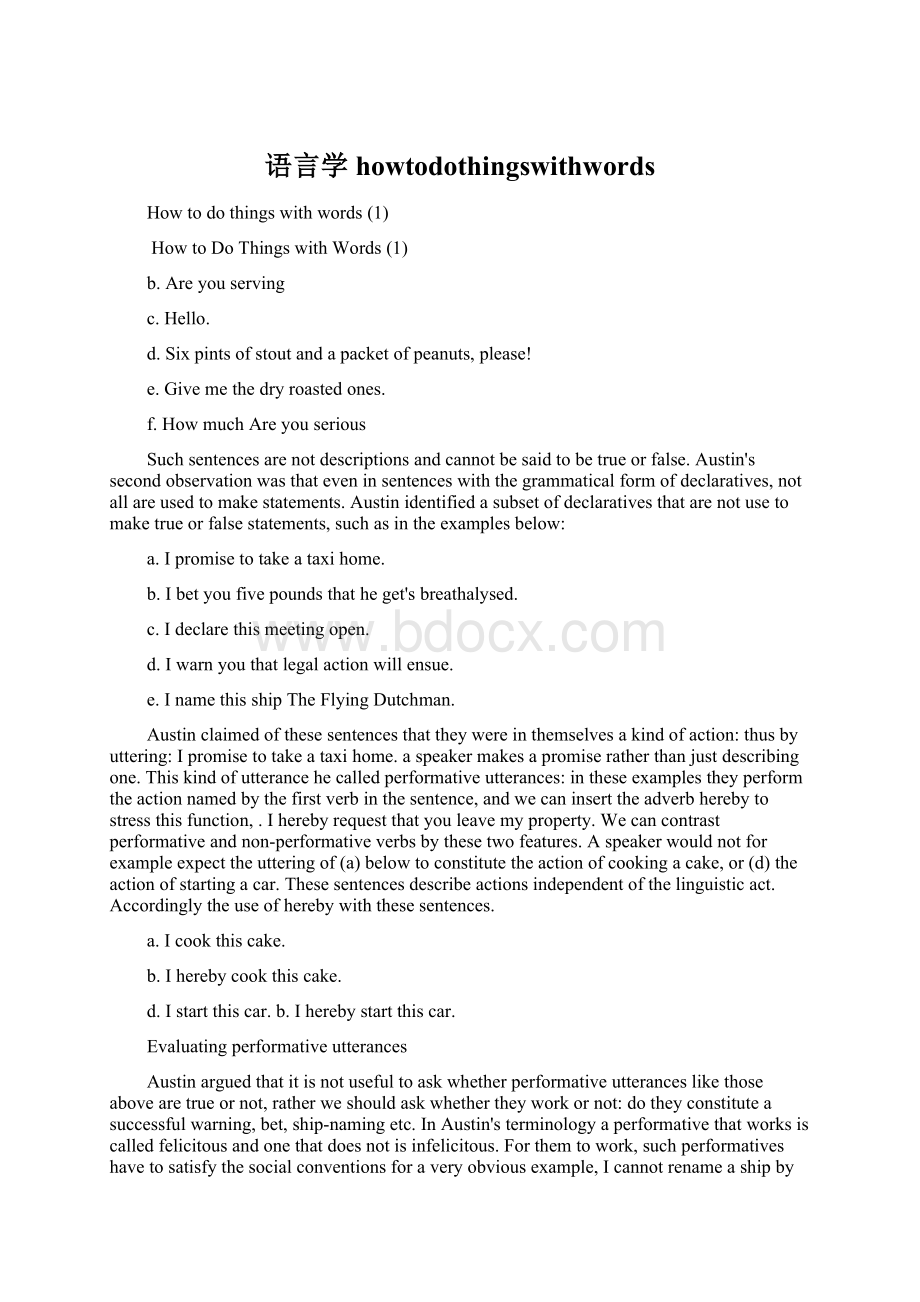语言学howtodothingswithwords.docx
《语言学howtodothingswithwords.docx》由会员分享,可在线阅读,更多相关《语言学howtodothingswithwords.docx(14页珍藏版)》请在冰豆网上搜索。

语言学howtodothingswithwords
Howtodothingswithwords
(1)
HowtoDoThingswithWords
(1)
b.Areyouserving
c.Hello.
d.Sixpintsofstoutandapacketofpeanuts,please!
e.Givemethedryroastedones.
f.HowmuchAreyouserious
Suchsentencesarenotdescriptionsandcannotbesaidtobetrueorfalse.Austin'ssecondobservationwasthateveninsentenceswiththegrammaticalformofdeclaratives,notallareusedtomakestatements.Austinidentifiedasubsetofdeclarativesthatarenotusetomaketrueorfalsestatements,suchasintheexamplesbelow:
a.Ipromisetotakeataxihome.
b.Ibetyoufivepoundsthatheget'sbreathalysed.
c.Ideclarethismeetingopen.
d.Iwarnyouthatlegalactionwillensue.
e.InamethisshipTheFlyingDutchman.
Austinclaimedofthesesentencesthattheywereinthemselvesakindofaction:
thusbyuttering:
Ipromisetotakeataxihome.aspeakermakesapromiseratherthanjustdescribingone.Thiskindofutterancehecalledperformativeutterances:
intheseexamplestheyperformtheactionnamedbythefirstverbinthesentence,andwecaninserttheadverbherebytostressthisfunction,.Iherebyrequestthatyouleavemyproperty.Wecancontrastperformativeandnon-performativeverbsbythesetwofeatures.Aspeakerwouldnotforexampleexpecttheutteringof(a)belowtoconstitutetheactionofcookingacake,or(d)theactionofstartingacar.Thesesentencesdescribeactionsindependentofthelinguisticact.Accordinglytheuseofherebywiththesesentences.
a.Icookthiscake.
b.Iherebycookthiscake.
d.Istartthiscar.b.Iherebystartthiscar.
Evaluatingperformativeutterances
Austinarguedthatitisnotusefultoaskwhetherperformativeutteranceslikethoseabovearetrueornot,ratherweshouldaskwhethertheyworkornot:
dotheyconstituteasuccessfulwarning,bet,ship-namingetc.InAustin'sterminologyaperformativethatworksiscalledfelicitousandonethatdoesnotisinfelicitous.Forthemtowork,suchperformativeshavetosatisfythesocialconventionsforaveryobviousexample,IcannotrenameashipbywalkinguptoitindockandsayingInamethisshiptheFlyingDutchman.Lessexplicitly,therearesocialconventionsgoverningthegivingoforderstoco-workers,greetingstrangers,etc.Austin'snamefortheenablingconditionsforaperformativeisfelicityconditions.Examiningthesesocialconventionsthatsupportperformatives,itisclearthatthereisagradientbetweenperformativesthatarehighlyinstitutionalized,orevenceremonial,requiringsophisticatedandveryovertsupport,liketheexampleofajudgepronouncingsentence,throughtolessformalactslikewarning,thanking,etc.Todescribetheroleoffelicityconditions,Austin(1975:
25-38)wroteaverygeneralschema:
HowtoDoThingswithWords
(2)
·Theremustexistanacceptedconventionalprocedurehavingacertainconventionaleffect,theproceduretoincludetheutteringofcertainwordsbycertainpersonsincertaincircumstances...
·Theparticularpersonsandcircumstancesmustbeappropriatefortheinvocationoftheparticularprocedureinvoked...
·Theproceduremustbeexecutedbyalltheparticipantscorrectly...
·...andcompletely...
Austinwentontoaddsincerityclauses:
firstlythatparticipantsmusthavetherequisitethoughts,feelingsandintentions,asspecifiedbytheprocedure,andsecondly,thatifsubsequentconductiscalledfor,theparticipantsmustsoconductthemselves.Ifthespeechactisunsuccessfulbyfailingthe
(1)or
(2)conditionsabove,thenhedescribeditasamisfire.ThusmycasuallyrenaminganyshipvisitingDublindocksisamisfirebecause
(2)aboveisnotadheredto.Iftheactisinsincerelyperformed,thenhedescribeditasanabuseofaspeechact,asforexamplesayingIbet...withnointentiontopay,orIpromise...whenIalreadyintendtobreakthepromise.Linguists,asopposedtophilosophers,havetendednottobesointerestedinthissecondtypeofinfelicity,sincetheprimaryspeechacthas,inthesecases,beensuccessfullycommunicated.
Explicitandimplicitperformatives
Lookingatexamplesofperformativeutterancesearlier,wecansaythattheyarecharacterizedbyspecialfeatures:
a.Theytendtobeginwithafirstpersonverbinaformwecoulddescribeassimplepresent:
Ibet,Iwarn,etc.
b.Thisverbbelongstoaspecialclassdescribingverbalactivitiesforexample:
promise,warn,sentence,name,bet,pronounce.
c.Generallytheirperformativenaturecanbeemphasizedbyinsertingtheadverbhereby,asdescribedearlier,thusIherebysentenceyouto....
Utteranceswiththesecharacteristicswecancallexplicitperformatives.TheimportanceofspeechacttheoryliesinthewaythatAustinandothersmanagedtoextendtheiranalysisfromtheseexplicitperformativestootherutterances.Thefirststepwastopointoutthatinsomecasesthesamespeechactseemstobeperformedbutwitharelaxationofsomeofthespecialcharacteristicsmentionedabove.Weregularlymeetutteranceslikethosebelow,wherethisisso:
a.Youare(hereby)chargedwithtreason.
b.Passengersarerequestedtoavoidjumpingoutoftheaircraft.
c.Fivepoundssayshedoesn'tmakethesemi-final.HowtoDoThingswithWords(3)
·Comeupandseemesometime.
Wecaneasilyprovidethesentencesabovewithcorrespondingexplicitperformatives,asbelow:
1.I(hereby)chargeyouwithtreason.
2.Werequestthatpassengersavoidjumpingoutoftheaircraft.
3.Ibetyoufivepoundsthathedoesn'tmakethesemi-final.
4.Iinviteyoutocomeupandseemesometime.
Itseemsreasonabletosaythatthesentences(a-d)couldbeutteredtoperformthesamespeechactsasthosein(1-4).Infactitseemsthatnoneofthespecialcharacteristicsofperformativeutterancesisindispensabletotheirperformance.Howthendowerecognizetheseotherperformatives,whichwecancallimplicitperformativesAnswerstothishavevariedsomewhatinthedevelopmentofthetheorybutAustin'soriginalcontentionwasthatitwasanutterance'sabilitytobeexpandedtoanexplicitperformativethatidentifieditasaperformativeutterance.Austindiscussedatlengththevariouslinguisticmeansbywhichmoreimplicitperformativescouldbemarked,includingthemoodoftheverb,auxiliaryverbs,intonation,etc.Weshallnotfollowthedetailofhisdiscussionhere;seeAustin(1975:
53-93).Ofcoursewesoonendupwithasituationwherethemajorityofperformativesareimplicit,needingexpansiontomakeexplicittheirforce.Onepositiveadvantageofthistranslationstrategyisthatitfocusesattentiononthetaskofclassifyingtheperformativeverbsofalanguage.Fornow,thebasicclaimisclear:
explicitperformativesareseenasmerelyaspecializedsubsetofperformativeswhosenatureasspeechactsismoreunambiguousthanmost.
Statementsasperformatives
Austin'soriginalpositionwasthatperformatives,whicharespeechactssubjecttofelicityconditions,aretobecontrastedwithdeclarativesentences,whicharepotentiallytrueorfalsedescriptionsofsituations.Thelatterweretermedconstatives.However,ashisanalysisdeveloped,hecollapsedthedistinctionandviewedthemakingofstatementsasjustanothertypeofspeechact,whichhecalledsimplystating.Again,weneedn'tfollowhislineofargumentcloselyhere:
seeAustin(1975:
133-47)andthediscussioninSchiffrin(1994:
50-4).Insimpleterms,Austinarguedthatthereisnotheoreticallysoundwaytodistinguishbetweenperformativesandconstatives.Forexample,thenotionoffelicityappliestostatementstoo:
statementswhichareoddbecauseofpresuppositionfailure,likethesentenceThekingofFranceisbalddiscussedearlier,areinfelicitousbecausethespeakerhasviolatedtheconventionsforreferringtoindividuals.thatthelistenercanidentifythem).Thisinfelicitysuspendsourjudgmentofthetruthorfalsityofthesentence:
itisdifficulttosaythatThekingofFranceisbaldisfalseinthesamewayasThepresidentofFranceisawoman,eventhoughtheyarebothnottrueatthetimeofwritingthis.Sowearriveataviewthatallutterancesconstitutespeechactsofonekindoranother.Forsomethetypeofactisexplicitlymarkedbytheircontainingaverblabelingtheact,warn,bet,name,suggest,protestetc.;othersaremoreimplicitlysignaled.Somespeechactsaresouniversalandfundamentalthattheirgrammaticalizationistheprofoundoneofthedistinctionintosentencetypeswementionedearlier.Intheircross-linguisticsurveyofspeechactsSadockandZwicky(1985:
160)observe:
Itisinsomerespectsasurprisingfactthatmostlanguagesaresimilarinpresentingthreebasicsentencetypeswithsimilarfunctionsandoftenstrikinglysimilarforms.Thesearethedeclarative,interrogative,andimperative.Asafirstapproximation,thesethreetypescanbedescribedasfollows:
Thedeclarativeisusedformakingannouncements,statingconclusions,makingclaims,relatingstories,andsoon.Theinterrogativeelicitsaverbalresponsefromtheaddressee.Itisusedprincipallytogaininformation.Theimperativeindicatesthespeaker'sdesiretoinfluencefutureevents.Itisofserviceinmakingrequests,givingorders,makingsuggestions,andthelike.
Thoughtheauthorsgoontodiscussthemanydetaileddifferencesbetweentheusesofthesemainformsinindividuallanguages,itseemsthatsentencetypeisabasicmarkerofprimaryperformativetypes.
Thisconclusionthatallutteranceshaveaspeechactforcehasledtoawidespreadviewthattherearetwobasicpartstomeaning:
theconventionalmeaningofthesentence(oftendescribedasaproposition)